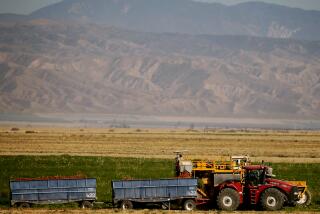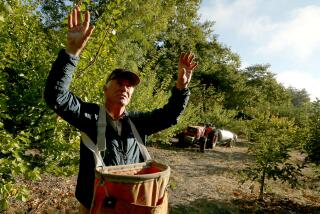Farms Avoid the Wrath of Drought--for Now : Agriculture: Crop production is expected to be unaffected this season, but next year may be a different story.
- Share via
IRVINE — As farmers in California’s Central Valley look with dread to the spring planting season, Orange County growers are worried about the drought but say they are confident it won’t hinder crop production, at least this year.
Furthermore, officials of local water agencies say that the State Water Project’s dramatic water cutoff to many agricultural areas, in an effort to preserve the remainder for cities, will have little impact here.
Farmers cite adequate reserves, sources other than big state and federal water projects, and a trend among themselves toward conservation as reasons for their optimism.
“In Irvine, we’re real fortunate in that we have water that’s not part of the drinking water supply,” said Carl Ballard, director of field operations for the Irvine Ranch Water District, supplier to most growers in the county. Ballard said local farmers don’t have to worry this year.
The 20,000-acre, $250-million farming business in Orange County, which includes orchards, nurseries and row crops, accounts for only 7% of the county’s total water use, contrasted with 83% statewide.
That relatively low proportion is due in part, say local farmers, to water-saving systems such as drip irrigation, recycling and computer-operated irrigation cycles that have cut their water consumption in some cases by as much as 65% in the last several years.
The outlook for farms outside Irvine, which is the county’s agricultural hub, is similar. The Los Alisos Water District, which serves a nursery and about 200 acres of orchards in South County, uses reclaimed water from a treatment plant, according to general manager Tom McFadden.
In Anaheim, the county’s second-largest user after Irvine Ranch, farming accounts for only 0.6% of usage. Any cutbacks will be apportioned among the few nurseries and farms, and no significant impact is expected, said Norris Creveston, a city water official.
Southern California’s major bulk water supplier, the Metropolitan Water District, which sells wholesale to local water agencies, has imposed the most stringent cutbacks in its history. Effective Feb. 1, the district called for a 30% reduction in agricultural water use and will consider a proposal Tuesday to cut that further to 50%.
Those immediate cuts will be softened for Orange County farmers because 60% of the water they use comes from wells and treated sewer water. About a third comes from MWD, but advance purchases have built up to the point that Irvine Lake, the main reservoir, is 80% full.
But looking beyond this year, local growers are concerned--particularly those who raise perennial crops like Valencia oranges, avocados and lemons. A fruit tree does not begin producing for three years and reaches its peak after about 10 years, according to Alan Reynolds, orchard manager for Treasure Farms, which plants 5,000 acres leased from the Irvine Co.
“We’re at the maximum. We can cut back without hurting the trees,” Reynolds said. “We utilize the most advanced technology possible.”
Reynolds’ orchards use either drip irrigation, where water is moved in pencil-thin plastic tubes almost directly to the roots, or mini-sprinklers. Both systems use about 4 gallons per hour. When Treasure Farms switched to furrow irrigation for its orchards, it saw a 40% savings, Reynolds said.
Drip irrigation is “very effective and substantially reduces the amount of water used,” according to Bill Miller, deputy commissioner of agriculture for Orange County.
Strawberry farmer Don Wall of Irvine also uses drip irrigation on his 80 acres, as he has for 10 years. He said installing the system cut his water use in half. Tensiometers measure the pressure in the soil of Wall’s fields, enabling a specialist to determine soil moisture and adjust watering accordingly.
In addition, Orange County growers have switched from thirsty crops like corn and melons to those that require less water, like red peppers and strawberries. They have also planted more specialty crops that produce a higher dollar yield per field. That higher yield, in turn, enables them to convert to expensive water-saving devices.
Some growers recycle water that runs off their fields. At Bordier’s Nursery in Irvine, a recycling pond collects “tail water,” or sprinkler runoff. The reclaimed water is mixed with fresh water, 3 parts to 1, and put back onto the plants, saving the nursery about 65%. Rick Dominge, general manager, said the nursery developed the system in 1985 in response to rising water costs “when we had no idea there would be a drought.”
The high price of water, which increased in 1982 and 1984, is a factor cited by all local growers in the trend toward more efficient irrigation systems.
“Pricing is a wonderful incentive” to conserve, said Keith Coolidge of the Municipal Water District of Orange County, the intermediary agency between the MWD and the smaller districts, such as Irvine Ranch. “Generally, Orange County agriculture is far more water-efficient simply because water costs them more.”
Until this week, Central Valley farmers enjoyed subsidized water at $47 per acre-foot from the federal Central Valley Project or the State Water Project. An acre-foot is the equivalent of what two average families would use in a year.
In contrast, Orange County farmers pay about $190 per acre-foot, according to Ballard of the Irvine Ranch Water District. Water for household use is about $230 an acre-foot.
The statewide impact of the drought this year, according to growers, means a reduction in planting, and probably higher produce prices for consumers.
“It’d probably be the best thing to happen to all of us,” said Wall, the strawberry farmer. “We’d make more money on less berries.”
More to Read
Sign up for Essential California
The most important California stories and recommendations in your inbox every morning.
You may occasionally receive promotional content from the Los Angeles Times.













